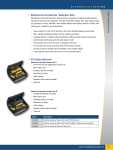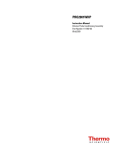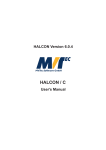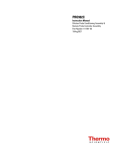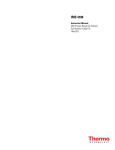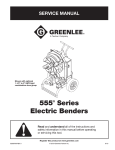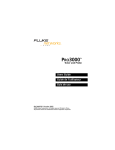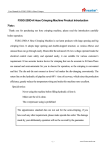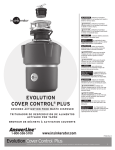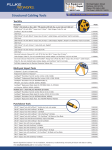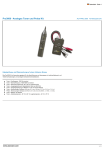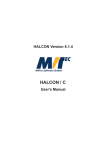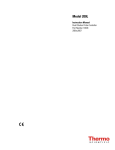Download Model PRO3000 - User Manual
Transcript
PRO3000 Instruction Manual Full Extractive Probe Assembly Part Number 111983-00 8Sep2008 © 2011 Thermo Fisher Scientific Inc. All rights reserved. Specifications, terms and pricing are subject to change. Not all products are available in all countries. Please consult your local sales representative for details. Thermo Fisher Scientific Air Quality Instruments 27 Forge Parkway Franklin, MA 02038 1-508-520-0430 www.thermoscientific.com/aqi WEEE Compliance This product is required to comply with the European Union’s Waste Electrical & Electronic Equipment (WEEE) Directive 2002/96/EC. It is marked with the following symbol: Thermo Fisher Scientific has contracted with one or more recycling/disposal companies in each EU Member State, and this product should be disposed of or recycled through them. Further information on Thermo Fisher Scientific’s compliance with these Directives, the recyclers in your country, and information on Thermo Fisher Scientific products which may assist the detection of substances subject to the RoHS Directive are available at: www. thermoscientific.com/WEEERoHS. Thermo Fisher Scientific WEEE Compliance Thermo Fisher Scientific WEEE Compliance Where to Get Help Service is available from exclusive distributors worldwide. Contact one of the phone numbers below for product support and technical information or visit us on the web at www.thermoscientific.com/aqi. 1-866-282-0430 Toll Free 1-508-520-0430 International We continue to support our customers with advanced online resources. Our Air Quality Instruments Online Library allows our customer’s access to product documents and information on a constant basis. Available 24-hours a day and seven-days a week, the online library provides quick access to information regardless of time zone or office hours. To register for an account or log in, please visit www.thermoscientific.com/aqilibrary. Thermo Fisher Scientific Where to Get Help PRO3000 TFS Claims For Damaged Shipments A. The Thermo Fisher Scientific (TFS) PRO3000 is shipped ready for operation. Immediate inspection of the TFS PRO3000 should follow upon receipt. Inventory of the container should be checked against the enclosed packing list. If there is a shortage of items, the operator should immediately contact TFS. If the contents are damaged, the carrier and TFS should be notified immediately. B. The following documents are necessary to support claims: 1. Original freight bill and bill of lading. 2. Original invoice or photocopy of original invoice. 3. Copy of the packing list. 4. Photographs of damaged equipment and container. NOTICE Material contained in this manual is proprietary information of TFS. The TFS manual is to be used only for the installation, operation, and servicing of this product. For further information or assistance contact: Thermo Fisher Scientific All rights reserved. No part of this publication may be reproduced or stored in a retrieval system or transmitted in any form or by any means, electronic, mechanical photocopying, recording, or otherwise, without the prior written permission of TFS. REVISION HISTORY Revision Pages Affected Revision No. 0 First issue 1 Added heated probe barrel information Rev 1 September 08, 2008 All All Revision Date May 30, 2008 Sept 8, 2008 ii PRO3000 TFS TABLE OF CONTENTS 1.0 PRODUCT DESCRIPTION ................................................................................ 1-1 1.1 Introduction.................................................................................................... 1-1 1.2 Probe Assembly Hardware ............................................................................ 1-1 1.3 Specifications................................................................................................. 1-3 2.0 THEORY OF OPERATION................................................................................ 2-1 2.1 General........................................................................................................... 2-1 2.2 Gas Flow Functional Description .................................................................. 2-1 2.2.1 Sampling Mode............................................................................... 2-1 2.2.2 Purge Mode..................................................................................... 2-2 2.2.3 Calibration Mode ............................................................................ 2-2 3.0 INSTALLATION AND OPERATION ............................................................... 3-1 3.1 Site Location and Preparation........................................................................ 3-1 3.2 Limitations at the Probe Site.......................................................................... 3-1 3.2.1 Stack Temperature Extremes .......................................................... 3-1 3.2.2 Ambient Temperature Extremes ..................................................... 3-2 3.2.3 Process Pressure.............................................................................. 3-2 3.3 General Installation........................................................................................ 3-3 3.3.1 Probe Assembly Enclosure ............................................................. 3-3 3.3.2 Air Supply/ Calibration Gas Line ................................................... 3-4 3.3.3 Sample Line .................................................................................... 3-4 3.3.4 Power .............................................................................................. 3-4 3.3.5 Control and Data Lines ................................................................... 3-4 3.4 Probe Assembly Start-up .............................................................................. 3-4 4.0 MAINTENANCE ...................................................................................................... 4-1 4.1 General........................................................................................................... 4-1 4.2 Required Maintenance Equipment ................................................................ 4-1 4.3 Heated Filter Replacement ............................................................................ 4-1 4.4 Trouble Shooting ........................................................................................... 4-2 4.4.1 Zero Drift - Full System.................................................................. 4-2 4.4.2 Span Drift - Full System ................................................................. 4-2 4.4.3 Low Sample Flow Rate................................................................... 4-2 4.4.4 Low Span Reading.......................................................................... 4-2 4.4.5 High Dew Point/Condensation in Sample Lines ............................ 4-3 5.0 RETURNING ASSEMBLIES FOR REPAIR ........................................................... 5-1 5.1 Obtaining Replacement Parts ........................................................................ 5-1 5.2 Spare Parts List, PRO3000 ............................................................................ 5-1 6.0 APPENDIX................................................................................................................ 6-1 Drawing # Rev Sheet Description 07040004 0 1 of 1 Filter, Assy, Heated, Extractive, Fiber Filter 07990181 0 1 of 1 Probe, Assy, Heated Barrel, for PRO3000 XXXX-7121-D 0, 1 of 2 Source Extractive Probe Flow Diagram XXXX-7131-D 0, 1 of 2 Source Extractive Probe Wiring Diagram XXXX-7151-D 0, 1 of 2 Source Extractive Probe Assembly XXXX-7151-D 0, 2 of 2 Source Extractive Probe Assembly Rev 1 September 08, 2008 iii PRO3000 1.0 TFS PRODUCT DESCRIPTION 1.1 Introduction The installation and operation manual provides instruction for basic installation, preventive maintenance, corrective maintenance, and trouble shooting procedures for the PRO3000 full extractive probe assembly that was developed to provide a lower cost, more reliable alternative to existing sampling systems. This manual contains four sections: Section 1 - Product Description: Hardware description, instrument operating parameters, and physical characteristics. Section 2 - Theory of Operation: Complete functional description. Section 3 - Installation and Operation: Instructions for installation and operation of the probe assembly. Section 4 - Maintenance: Routine inspection, trouble shooting, corrective procedures, and repair/replacement for major assemblies. 1.2 Probe Assembly Hardware The PRO3000 probe assembly consists of an enclosure containing a probe barrel (optional heated probe barrel), a heated filter assembly, purge/calibration gas valves and temperature controlling electronics (see Figure 1.2-1). The PRO3000 is attached to the stack by a four-inch pipe flange, or may be fitted with a 2.5, 3 or 6-inch flange to suit existing sampling ports. The probe barrel is inserted into the stack through an opening in the back of the assembly enclosure. Figure 1.2-1 PRO3000 Probe Box Rev 1 September 08, 2008 1-1 PRO3000 TFS The probe assembly consists of a stainless steel probe barrel and a heated filter assembly shown in Figure 1.2-2. A heated, high capacity, sub-micron filter is housed in a stainless steel filter body that is located within the heated filter assembly, and can be easily replaced during preventive maintenance. The sampling probe barrel is typically a section of heavy wall tubing with an outer diameter of 5/8 inches and an inner diameter of .425 inches. Material for the probe barrel is selected for compatibility with the process stream and is most frequently supplied in 316 stainless steel. The sample probe is housed in a fiberglass enclosure that measures approximately 20 inches (H) by 20 inches (W) by 10 inches (D). The enclosure is designed to protect instruments and electrical controls from highly corrosive atmospheres. Enclosure material other than the standard fiberglass may be selected to suit special ambient conditions at the sampling point. HEATED FILTER ASSEMBLY PROBE BARREL SAMPLE/PURGE CAL GAS Figure 1.2-2 PRO3000 Heated Probe Assembly Rev 1 September 08, 2008 1-2 PRO3000 TFS 1.3 Specifications The PRO3000 probe assembly was designed to operate within the following specifications. Power Requirements: 120 VAC, 300 Watts (1300 Watts if equipped with heated probe barrel) Power Connection: CSA/UL Approved screw terminal. Terminal wire capacity up to 10 AWG. Ambient Operating Temperature Range: -25° C (-13° F) to 50° C (122° F) Maximum Process Temperature: 600° C (1112° F) Calibration Gas Flow Rate: 5.0 L/min minimum Instrument Air Supply: 60 PSIG minimum 80 PSIG maximum via 1/2 inch tubing - 0.300 inch I.D. min. Heated Filter Assembly Temperature: 300° F ± 5° F Heated Probe Barrel Assembly Temperature: 300° F ± 5° F Materials of Construction: Enclosure: Fiberglass Stainless Steel (optional) Mounting Flange: Stainless Steel, 4 inch standard pipe Optional: 2.5 to 6 inch Heated Filter Body: 316 Stainless Steel Probe Barrel: 316 Stainless Steel Hastelloy C-276 (optional) Connecting Lines/ Sample Lines: Weight of Probe Assembly: Rev 1 Teflon 39 lbs. (17.7 kg) 52.5 lbs. (23.8 kg) with heated probe September 08, 2008 1-3 PRO3000 2.0 TFS THEORY OF OPERATION 2.1 General The PRO3000 full extractive probe assembly is used to extract and condition a continuous sample from a stack or duct for transport to a gas analysis system. 2.2 Gas Flow Functional Description Operation of the probe assembly consists of three modes: Sampling, Purge, and Calibration Modes. 2.2.1 Sampling Mode Process gas enters the sampling system at the probe barrel tip. The process gas moves down the probe barrel at a flow rate of 2.5-5 L/min. From the sampling probe, the gas enters the probe enclosure and flows into the heated filter, shown in cross section in Figure 2.2.1-1. The filter element is temperature controlled at 300° F ± 5° F by a band heater element and an external electronic temperature controller. The filter element is selected for its inertness to the process gas and is a borosilicate glass fiber element having collection efficiency rating of 0.1 micron. The filter element may be removed by removing the filter cap. A port is provided to introduce purge air and calibration gas. The heated filter body is fabricated from 316 stainless steel to minimize sample contamination due to unwanted reactions with the process gas. After passing through the heated filter element, the filtered process gas flows through a heat traced umbilical which is maintained at 300°F ±5° F. Process gas is pulled through the heated filter and the heated Teflon® sample line by a sample transport pump located in sample chiller assembly in the remote analysis system. From the sample line, the process gas flows through a sample chiller, an orifice protection filter, through a flow control orifice and then through the sample transport pump to the bypass vent. This bypass vent flow is used to establish a reasonable transport time (usually less than 20 seconds). The bypass flow can be used by other gas analyzers attached to the bypass vent. The flow control orifice is selected to obtain a desired flow rate to the remote analyzer. This sample is then drawn to a gas analyzer via an internal pump in order to generate an electrical signal proportional to the specific gas being analyzed. From the remote analyzer, the diluted process gas flows to a vent manifold. 2.2.2 Purge Mode The probe is cleaned periodically by introducing high-pressure purge air from the purge air solenoid valve (SV1 & SV2) into the filter body and exiting into the process through the sample probe. The analysis system controller operates the purge solenoid valve automatically. A manual purge may be initiated from the controller at any time but the preferred method is to automatically energize the purge/cal gas solenoid valve. Purge frequencies may vary from every 15 minutes for applications with extremely heavy particulate concentrations to several hours for cleaner applications. The purge pulse lasts approximately 10 seconds. Longer purge times Rev 1 September 08, 2008 2-1 PRO3000 TFS could result in heated filter cooling. 2.2.3 Calibration Mode The PRO3000 probe assembly is calibrated by passing a gas of known concentration through all the components in the sample analysis system and adjusting the response of the gas analysis system to equal the value of the known calibration gas. Calibrating in this manner allows for compensation of the total system for losses in filter elements or other pneumatic components, and in process gas flow rates. A typical calibration gas flow path is as follows: From the calibration cylinder, the calibration gas flows from a flow controlling device and calibration gas valve located in the valve/ switch chassis, through the calibration gas line to the cal gas check valve and then to the cal gas inlet in the tee fitting which supports the heated filter assembly. The gas enters the filter body through the calibration gas inlet. The remote calibration gas solenoid valve allows the flow of calibration gas to be initiated remotely through a controller in the remote analysis system. From the inlet tee fitting, the calibration gas passes through all system components at the same flow rates and conditions as the process sample gas. Rev 1 September 08, 2008 2-2 PRO3000 TFS 3.0 INSTALLATION AND OPERATION 3.1 Site Location and Preparation The 40 CFR Performance Specification Two (2) provides a guide to proper site selection and lists several points that should be considered for most applications. The most accurate readings will usually be obtained when the guidelines of Performance Specification Two (2) are followed. The PRO3000 extractive probe conditioning assembly is installed on a four (4) inch pipe flange. The pipe flange must be installed on a pipe nipple extending six (6) inches from the outer wall of the stack. The pipe nipple is used to allow clearance behind the conditioning assembly for installation of the four (4) 1/2-inch X 1 3/4-inch stainless steel mounting bolts. Also allow a clear space, at least the width of the probe enclosure, in front of the enclosure door to allow the door to be opened. The four (4) inch pipe flange must be aligned as shown in Figure 3.1-1. A slip-type pipe flange is recommended to insure that the conditioning assembly can be leveled. The extractive probe assembly should be installed in a location that will allow maintenance personnel access to the front of the enclosure. All maintenance can be performed from the front of the unit. 3.2 Limitations at the Probe Site The placement of the PRO3000 probe assembly is important to achieve its maximum reliability. 3.2.1 Stack Temperature Extremes The PRO3000 probe barrel may be supplied using several different materials. Specific limitations for each probe barrel type must be considered separately. A) 316 stainless steel probe barrel A 316 stainless steel probe barrel is used at temperatures up to 1200° F with lengths up to six (6) feet. Additional lengths can be use with the optional probe barrel support. B) Hastelloy C-276 Probe Barrel: A Hastelloy C-276 probe barrel may be used in installations that require abrasion resistant material for the probe with lengths up to six (6) feet. Additional lengths can be use with the optional probe barrel support. It is best to use the shortest possible probe barrel length for response times and consistent with good sampling practice. Rev 1 September 08, 2008 3-1 PRO3000 TFS 22.5° 90 .0° (NOTE-1) 52" 48" (NOTE-4) (NOTE-3) 7" (NOTE-5 & 6) (NOTE-2) 5° 1 4 1 4 VIEW 'A'-'A' FLANGE WELDED TO PIPE SPOOL IN THIS CONFIGURATION UNLINED PROBE EXTENDING INTO STACK 5/8" TUBE 316 SS (NOTE-4) MAINTENANCE CLEARANCE (NOTE-7, 8, 9) (DETAIL-A) 10.32 1. DO NOT ALLOW BURRS ON INSIDE DIAMETER OF 4" SCHEDULE 40 PIPE (SUPPLIED BY CUSTOMER) 2. WELD PIPE TO STACK USING 1/4" FILLET WELD 3. (A) - USE THESE FOUR HOLES FOR PROBE INSTALLATION 4. PROBE LENGTH WILL MEET US EPA 1 METER PENETRATION REQUIREMENT; MAY BE SHORTENED, IF NECESSARY, TO PLACE PROBE TIP AT CENTER OF GAS STREAM 48" (MINIMUM) 72" (MAXIMUM) STACK WALL NOTES: 5. ALLOW 7" CLEARANCE BETWEEN FLANGE AND WALL OR FLANGE AND INSULATION CATWALK OR FLOOR 6. CUSTOMER IS TO ENSURE THE STRUCTURAL INTEGRITY OF THE STACK OR DUCT AT ALL PENETRATIONS 7. ALLOW 16" CLEARANCE FOR DOOR OPENING 8. ALLOW CLEARANCE IN FRONT OF PROBE BOX FOR PROBE REMOVAL 48" (RECOMMENDED MINIMUM) 9. CLEARANCE FOR MAINTENANCE Figure 3.1-1 PRO3000 Probe Box Installation 3.2.2 Ambient Temperature Extremes The PRO3000 probe assembly may be operated at a maximum ambient temperature of 50° C (140° F). Optimum operation of the sampling system will always be achieved if a sampling location is selected with moderate temperatures. 3.2.3 Process Pressure The sampling system should not be installed in sampling locations that have pressures which exceed ± 30 inches H2O. Positive pressure ducts are a special problem in that the maintenance is complicated by process gases escaping into the area of the maintenance personnel when the filter body is opened for maintenance. Positive pressure stacks or ducts may be easily sampled if a small portion of the stream can be vented to atmosphere and the probe is then allowed to sample this atmospheric vent. The probe typically extracts between 2.5 and 5.0 L/min. Rev 1 September 08, 2008 3-2 PRO3000 TFS 3.3 General Installation 3.3.1 Probe Assembly Enclosure The probe assembly is shipped in two separate containers. The probe enclosure is installed first and then the probe is installed through an opening in the back of the enclosure into the stack. To install the probe assembly, perform the steps as outlined in the following three sections. Probe Enclosure Installation Install the enclosure on the four (4) inch flange using a proper flange gasket and four 1/2 inch X 1 3/4 inch stainless steel bolts, (See Figure 3.3.1-2). 22.5° FULL FACE FLANGE GASKET (SUPPLIED BY CUSTOMER) 'A' 4" SCH 40 PIPE (NOTE-6) PROBE BOX (NOTE-1) 90 .0° 1/2"-13 UNC SS NUT, LOCK AND FLAT WASHER. (SUPPLIED BY VENDOR) (NOTE-2) 4" 150# RF FLANGE (SUPPLIED BY CUSTOMER) 'A' VIEW 'A'-'A' NOTES: 1. DO NOT ALLOW BURRS ON INSIDE DIAMETER OF 4" SCHEDULE 40 PIPE (SUPPLIED BY CUSTOMER) FLANGE WELDED TO PIPE SPOOL IN THIS CONFIGURATION 2. (A) - USE THESE FOUR HOLES FOR PROBE INSTALLATION Figure 3.3.1-2 Customer Pipe Spool Installation A) Inspect the probe barrel assembly for proper flange spacing and orientation (factory set), Figure 3.3.1-2. B) Install the probe flange gasket (factory supplied) over the process end of the probe barrel to be used to seal process gases from the enclosure. C) Insert the probe barrel assembly through the flange porthole in the back of the enclosure with the bend downward. Align the three-hole probe-mounting flange and flange gasket to the threehole pattern of the enclosure flange porthole. D) Insert the three (3) supplied 1/4-20 X 1-3/4 inch bolts through the probe mounting flange into the threaded holes, and tighten. E) If equipped with a heated probe barrel, connect the probe barrel heater leads and the probe barrel RTD leads to the terminal strip in the lower compartment. Rev 1 September 08, 2008 3-3 PRO3000 TFS Probe Head Installation A) Connect the sample/purge tube. B) Connect the calibration tube. C) Connect the probe filter heater band heater to the terminal strip in the lower compartment. Verify that the band heater is tightly clamped to the heated filter body. D) Insert the temperature controller RTD into the hole provided, install the retaining screw and connect the leads to the terminal strip in the lower compartment. Check all connections. 3.3.2 Calibration Gas Line Connect the Teflon® calibration gas line to the appropriate 3/8" inch stainless steel compression tube fitting located on the right side of support plate in the enclosure. 3.3.3 Air Supply/Sample Line Connect the Teflon® sample line and purge air line to the appropriate 3/8-inch compression type tube fittings located on the left side of support plate in the enclosure. The maximum length for the sample and calibration lines varies with individual applications. (Refer to the specific installation drawings for each application.) 3.3.4 Control and Signal Lines The control and signal lines are part of the tubing/wiring umbilical. Connect the control lines and signal lines using specified shielded cable for the heated filter temperature control and signal. (Refer to specific installation drawings for each application.) 3.4 Probe Assembly Start-up The probe assembly may be started up as follows: A) Locate the probe head temperature controller, located in the probe controller CTL3000 in the rack. Confirm that the proper parameters are entered into the temperature controllers (Refer to the CTL3000 series probe controller manual). B) Verify that the band heater is tightly clamped to the heated filter body. C) Turn on the controller AC power switch at the rack. D) Insert a thermocouple temperature probe in one of the test port located above the RTD port in the heated filter body and allow the temperature to stabilize. This temperature should be 300° Rev 1 September 08, 2008 3-4 PRO3000 TFS F. E) Increase or decrease the temperature adjustment of the CTL3000 heated filter temperature controller to obtain a probe head temperature of 300° F ± 5° F. Allow temperature to stabilize to confirm that the heater circuitry is controlling properly. The temperature of the heated filter may be adjusted as required. (If equipped with a heated probe barrel, perform the same adjustment on the heated probe barrel temperature controller.) F) Turn on the main air supply from the air clean-up assembly (if supplied) and adjust the air supply to 60PSI. G) Initiate a purge cycle on the probe assembly from the system controller. The PRO3000 probe assembly is now ready to be calibrated with the complete monitoring system. Rev 1 September 08, 2008 3-5 PRO3000 4.0 TFS MAINTENANCE 4.1 General The following procedures are designed to allow the maintenance technician to accomplish all necessary maintenance procedures on the PRO3000 probe assembly. 4.2 Required Maintenance Equipment To perform maintenance on the sample system, the following equipment is required. A. Normal hand tools 4.3 Heated Filter Replacement NOTE: The existing heated filter must be replaced with a new one each time the filter cap is removed, (the filter is slightly crushed to seal). Once a crushed filter is removed, it will not seal properly and can not be used again. CAUTION: THE STAINLESS STEEL FILTER BODY OPERATES AT 300° F AND CAN CAUSE SEVERE BURNS. USE EXTREME CARE WHEN WORKING IN THE UPPER SECTION OF THE PROBE ENCLOSURE. A) Remove the heated filter cap. B) Remove the filter from the mandrill of the heated filter cap. C) Inspect the filter body and cap for particulate accumulation around the filter seats. Clean the filter body and seat by wiping with a soft cloth. D) Install a new filter element onto the cap mandrill, then insert the cap and filter into the filter body. Tighten the filter cap until it contacts the filter body. 4.4Trouble Shooting 4.4.1 Zero Drift - Full System Zero drift is independent of the dilution system, as any dilution of a zero gas will still cause a zero indication on the analyzer. Check the analyzer location for large temperature changes or other changes in the analyzer utilities. Please see the system manual for zero drift calculations. 4.4.2 Span Drift - Full System Span drift may be caused by many different variables throughout the monitoring system. Most problems with the sampling system will be indicated by a failure to pass the daily span calibration. Failure to pass the daily calibration is subdivided into several different Rev 1 September 08, 2008 4-1 PRO3000 TFS problem areas that would cause a high or low indication on daily calibration. For each possible problem, a corrective action is listed. Please see the system manual for span drift calculations. 4.4.3 Low Sample Flow Rate Possible Problem - Leak between filter body and probe barrel, sample outlet or purge inlet. Corrective Action: Remove the probe barrel/heated filter assembly, plug the probe barrel and sample outlet and pressurize to 30 psi. Check for a leak at the probe barrel, sample outlet fitting or cal gas inlet. If a leak is detected, tighten the fitting and repeat the leak check. Possible Problem - Leak around filter cap. Corrective Action: Replace cap o-ring. 4.4.4 Low Span Reading Possible Problem - Dirty Main Filter element. Corrective Action: Replace filter element. Possible Problem - Leak at filter body cap. Corrective Action: Replace filter cap o-ring. Replace filter. Possible Problem - Leak at sample and cal gas valve connections. Corrective Action: Check for leaks. Tighten connections as required. Possible Problem - Leaky purge/cal gas valve. Corrective Action: Replace valve. 4.4.5 High Dew Point/Condensation in Sample Lines Possible Problem - Failure of filter heaters or solid state relay. Corrective Action: Check heater and heater solid state relay. Replace if defective. Rev 1 September 08, 2008 4-2 PRO3000 TFS 5.0 Returning Assemblies for Repair Should it become necessary to return any assembly, sub-assembly, or component for repair or replacement, contact the factory prior to shipment for specific information such as return authorization number, shipping instructions, price, time to repair, etc. Also include pertinent facts describing the nature of the problem. Ship all components to the following: Thermo Fisher Scientific 5.1 Obtaining Replacement Parts The following information must be included in all purchase orders for parts: A. TFS Model and S/N of major assembly B. Part Number (found in parts tables) C. Description of part 5.2 Spare Parts List, PRO3000 Part Number Description Recommended Quantity 25503012 O-ring, filter body 2* 26002018 Filter, 0.1 Micron, STD 4* 45510062 Valve, 2 way NC 120V 1/4NPT-3/16 orifice 1* 53010098 Heater band, 300 Watt, 1.5” wide, 120 VAC 2* 53040025 RTD, .25” x 1.5” HEATER, ROD, 95", 120VAC, 1000W 1* 53040051** 1* 1* RTD, PROBE, 24" 316 SHEATH, 12" FG * THESE PARTS ARE RECOMMENDED AS A MINIMUM FROM THE TFS SERVICE DEPARTMENT TO AID IN ACQUIRING 98 % UP TIME. 53040128** **THESE PARTS USED IN THE HEATED PROBE ONLY. Teflon® is a registered trademark of E. I. duPont de Nemours & Company, Inc. Gore-tex® is a registered trademark of W. L. Gore & Associates, Inc Rev 1 September 08, 2008 5-1 PRO3000 TFS 6.0 APPENDIX A Drawing # Rev 07040004 0 1 of 1 Filter, Assy, Heated, Extractive, Fiber Filter 07990181 0 1 of 1 Probe, Assy, Heated Barrel, for PRO3000 XXXX7121 0, 1 of 1 Source Extractive Probe Flow Diagram XXXX7131 0, 1 of 1 Source Extractive Probe Wiring Diagram XXXX7151 0, 1 of 2 Source Extractive Probe Assembly XXXX7151 0, 2 of 2 Source Extractive Probe Assembly Rev 1 Sheet Description September 08, 2008 6-1 Warranty Warranty Seller warrants that the Products will operate or perform substantially in conformance with Seller's published specifications and be free from defects in material and workmanship, when subjected to normal, proper and intended usage by properly trained personnel, for the period of time set forth in the product documentation, published specifications or package inserts. If a period of time is not specified in Seller’s product documentation, published specifications or package inserts, the warranty period shall be one (1) year from the date of shipment to Buyer for equipment and ninety (90) days for all other products (the "Warranty Period"). Seller agrees during the Warranty Period, to repair or replace, at Seller's option, defective Products so as to cause the same to operate in substantial conformance with said published specifications; provided that (a) Buyer shall promptly notify Seller in writing upon the discovery of any defect, which notice shall include the product model and serial number (if applicable) and details of the warranty claim; (b) after Seller’s review, Seller will provide Buyer with service data and/or a Return Material Authorization (“RMA”), which may include biohazard decontamination procedures and other product-specific handling instructions; and (c) then, if applicable, Buyer may return the defective Products to Seller with all costs prepaid by Buyer. Replacement parts may be new or refurbished, at the election of Seller. All replaced parts shall become the property of Seller. Shipment to Buyer of repaired or replacement Products shall be made in accordance with the Delivery provisions of the Seller’s Terms and Conditions of Sale. Consumables, including but not limited to lamps, fuses, batteries, bulbs and other such expendable items, are expressly excluded from the warranty under this warranty. Notwithstanding the foregoing, Products supplied by Seller that are obtained by Seller from an original manufacturer or third party supplier are not warranted by Seller, but Seller agrees to assign to Buyer any warranty rights in such Product that Seller may have from the original manufacturer or third party supplier, to the extent such assignment is allowed by such original manufacturer or third party supplier. In no event shall Seller have any obligation to make repairs, replacements or corrections required, in whole or in part, as the result of (i) normal wear and tear, (ii) accident, disaster or event of force majeure, (iii) misuse, fault or negligence of or by Buyer, (iv) use of the Products in a manner for which Thermo Fisher Scientific Warranty they were not designed, (v) causes external to the Products such as, but not limited to, power failure or electrical power surges, (vi) improper storage and handling of the Products or (vii) use of the Products in combination with equipment or software not supplied by Seller. If Seller determines that Products for which Buyer has requested warranty services are not covered by the warranty hereunder, Buyer shall pay or reimburse Seller for all costs of investigating and responding to such request at Seller's then prevailing time and materials rates. If Seller provides repair services or replacement parts that are not covered by the warranty provided in this warranty, Buyer shall pay Seller therefor at Seller's then prevailing time and materials rates. ANY INSTALLATION, MAINTENANCE, REPAIR, SERVICE, RELOCATION OR ALTERATION TO OR OF, OR OTHER TAMPERING WITH, THE PRODUCTS PERFORMED BY ANY PERSON OR ENTITY OTHER THAN SELLER WITHOUT SELLER'S PRIOR WRITTEN APPROVAL, OR ANY USE OF REPLACEMENT PARTS NOT SUPPLIED BY SELLER, SHALL IMMEDIATELY VOID AND CANCEL ALL WARRANTIES WITH RESPECT TO THE AFFECTED PRODUCTS. THE OBLIGATIONS CREATED BY THIS WARRANTY STATEMENT TO REPAIR OR REPLACE A DEFECTIVE PRODUCT SHALL BE THE SOLE REMEDY OF BUYER IN THE EVENT OF A DEFECTIVE PRODUCT. EXCEPT AS EXPRESSLY PROVIDED IN THIS WARRANTY STATEMENT, SELLER DISCLAIMS ALL OTHER WARRANTIES, WHETHER EXPRESS OR IMPLIED, ORAL OR WRITTEN, WITH RESPECT TO THE PRODUCTS, INCLUDING WITHOUT LIMITATION ALL IMPLIED WARRANTIES OF MERCHANTABILITY OR FITNESS FOR ANY PARTICULAR PURPOSE. SELLER DOES NOT WARRANT THAT THE PRODUCTS ARE ERROR-FREE OR WILL ACCOMPLISH ANY PARTICULAR RESULT. Warranty Thermo Fisher Scientific
























